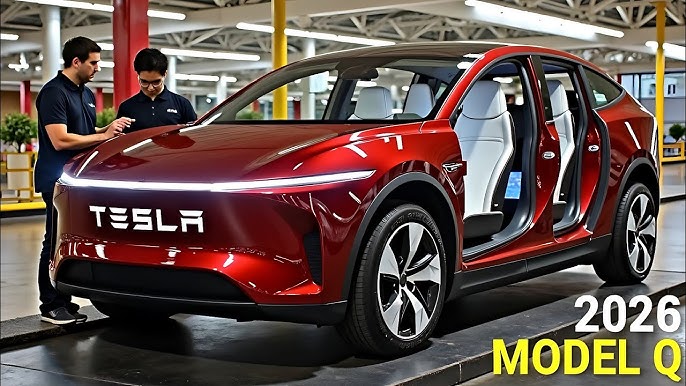2026 Tesla Model Q FIRST LOOK – Elon Musk’s Most Enigmatic Electric Vehicle to Date!

Under the hood, the Model Q is expected to feature Tesla’s latest dual motor all-wheel drive system, delivering exhilarating acceleration with 0 to 60 mph times potentially under four seconds. A massive battery pack is anticipated to yield an impressive range of over 350 miles, catering to both adventurous road trips and everyday commuting. Inside, the cabin resembles a high-tech cockpit, complete with a panoramic glass roof and a prominent touchscreen display that controls various vehicle functions.

Let’s get one thing straight first. We like Tesla here at Electrifying. We think the cars are great: incredibly efficient, easy to recharge on the move and (now) decently put together. We also like the brand. Tesla’s UK division has never once ducked a request or awkward question from and has always provided us with access to test vehicles – often at crazily short notice. Tesla has probably won more head-to-head shoot-outs than any other brand in our videos and we’d recommend the cars to anyone.

So why are we writing an article about choosing cars that don’t wear the famous T badge? In recent weeks, it has become apparent that the actions and behaviour of Tesla’s CEO have prompted many potential and even current owners to reconsider their choices. In January, we conducted an online poll* and found that nearly two-thirds of car buyers say they are now put off buying a Tesla due to Elon. This sentiment is consistent across both current electric vehicle (EV) owners and those intending to purchase one, with 59% in each group expressing that Musk’s influence would deter them from choosing a Tesla.

While you could quite reasonably argue that the politics of a car brand’s owner have nothing to do with the products themselves, that doesn’t really apply in this case. To a lot of people, Tesla is Elon Musk and Elon Musk is Tesla. And to many, buying or driving a Tesla is somehow endorsing the often controversial views of the owner.

If you’re one of those people, this article is for you. Over recent weeks, our postbag if you want to add to it) has been peppered with a number of emails asking for Tesla alternatives. And, because I’m fundamentally lazy and have cramp from replying to so many, I figured that writing this feature would pay off in the long term.
The Polestar 3 combines Scandinavian design with cutting-edge technology into one rather lovely package. The 3’s front grille, distinctive lighting, and clean silhouette give it a premium, yet purposeful presence. Inside, the cabin is equally impressive, offering a minimalist design with high-quality materials. The tech-forward interior features a large, portrait-oriented touchscreen that seamlessly integrates with Google’s Android operating system. The intuitive infotainment system is responsive and packed with features, while the seats offer excellent comfort for both front and rear passengers.
Performance is another strong suit. The Polestar 3 comes with dual motors and a substantial 111 kWh battery, delivering a thunderous 517bhp and a 0-62 mph time of around 4.5 seconds. The range is competitive, with estimates of up to 379 miles on a full charge, depending on the configuration.
While the handling is precise and refined, it’s not quite as dynamic as some sportier rivals in this segment. However, the 3’s combination of luxury, practicality, and performance makes it a decent Model Y alternative.

It may not be quite the head-turner it was at launch nearly four years ago, but the IONIQ 5 remains one of the coolest-looking EVs on the market, offering a strong blend of design, technology, and practicality. It rides on Hyundai’s dedicated E-GMP platform, which allows for a long wheelbase, a flat floor, and impressive cabin space. The exterior styling remains a key talking point, with those retro-futuristic look and pixel-style LED lighting setting it apart from more conventional electric SUVs.
The entry-level Hyundai Ioniq 5 RWD 170 offers a 60kWh battery (up from 54kWh) and 168bhp, delivering a 0-62mph time of 8.5 seconds. The RWD 228 improves on this with an 80kWh battery (up from 74kWh) and 225bhp, offering a quicker 7.5-second 0-62mph time, though the extra cost may not be justified unless you need more range. The AWD 325 has the same 80kWh battery but adds a second motor for a total of 321bhp, reducing the 0-62mph time to 5.3 seconds. Range varies from 273 to 354 miles depending on the version,
The interior is just as forward-thinking, with sustainable materials, a minimalist dashboard, and dual 12.3-inch screens. Passenger space is generous, and there’s a focus on comfort rather than outright sportiness. While it’s not the most dynamic EV to drive, it remains a well-rounded and highly appealing option in the electric SUV market.



